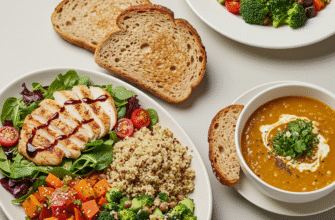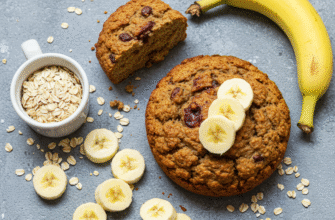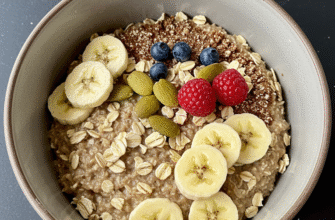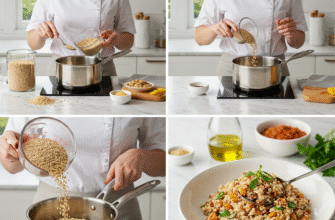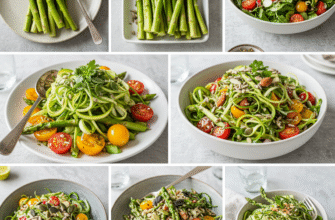Often overshadowed by their leafy namesake, Jerusalem artichokes, also known charmingly as sunchokes, are knobbly tubers that deserve a prime spot in your kitchen repertoire. They possess a unique, slightly sweet, nutty flavor reminiscent of water chestnuts or, yes, artichoke hearts, but with an earthier undertone. Raw, they offer a delightful crunch, perfect for salads, but cooking transforms them into something tender, creamy, and deeply satisfying. Beyond their intriguing taste, sunchokes are packed with nutritional goodness, particularly the prebiotic fiber inulin, making them a fantastic addition to a health-conscious diet. Let’s explore some delicious and wholesome ways to unlock the potential of these versatile veggies.
Getting Started: Selecting and Prepping Sunchokes
Your sunchoke journey begins at the market or grocery store. Look for tubers that are firm to the touch, with taut skin and minimal soft spots or blemishes. Size doesn’t necessarily dictate quality, but smoother, less knobbly ones are certainly easier to clean and prepare. Avoid any that look shriveled or feel spongy.
Once home, store them unwashed in a paper bag or perforated plastic bag in the crisper drawer of your refrigerator. They prefer cool, dark, and slightly humid conditions and can last for a week or two this way.
When you’re ready to cook, the main task is cleaning. Sunchokes grow underground and their irregular shapes trap soil easily. Give them a thorough scrub under cold running water using a stiff vegetable brush. Pay attention to the nooks and crannies. Now, the big question: to peel or not to peel? The skin is entirely edible, thin, and contains nutrients. Leaving it on adds a slightly rustic texture and saves considerable prep time. However, if you prefer a smoother texture, particularly for purées or mashes, or if the skins are particularly tough or blemished, peeling is an option. A vegetable peeler works, but tackling the bumps can be tricky; sometimes using a small paring knife or even the edge of a spoon is more effective. After scrubbing or peeling, drop them into a bowl of water with a squeeze of lemon juice or a splash of vinegar to prevent discoloration, as they oxidize quickly once cut.
Roasting: The Crowd-Pleasing Classic
Roasting is arguably the most popular and foolproof way to prepare Jerusalem artichokes. It concentrates their natural sweetness and creates delightfully crispy edges while keeping the inside tender. The process is wonderfully simple.
Preheat your oven to a reasonably high temperature, around 400F (200C). While the oven heats, chop your cleaned sunchokes into bite-sized pieces, roughly 1-inch cubes or wedges. Uniformity helps ensure even cooking. Toss the pieces generously with a good quality olive oil – just enough to coat them without drowning them. Season simply with sea salt and freshly ground black pepper. Now, get creative! Toss in a few sprigs of fresh thyme or rosemary, some smashed garlic cloves (skin on is fine), or even a pinch of red pepper flakes for a little heat.
Spread the seasoned sunchokes in a single layer on a large baking sheet. Avoid overcrowding the pan, as this leads to steaming rather than roasting; use two pans if necessary. Roast for 25-40 minutes, flipping them halfway through. The exact time depends on the size of your pieces and your oven. They’re ready when they are fork-tender, golden brown, and slightly caramelized around the edges. Roasted sunchokes are fantastic served immediately as a side dish, tossed into warm salads, or even eaten as a snack.
Roasting Variations
- Lemony Zing: Add lemon wedges to the roasting pan alongside the sunchokes. Squeeze the roasted lemon juice over them before serving.
- Cheesy Finish: Sprinkle with grated Parmesan or Pecorino cheese during the last 5-10 minutes of roasting.
- Nutty Crunch: Toss with chopped walnuts or hazelnuts before serving for added texture.
Silky Sunchoke Soup: Comfort in a Bowl
The creamy texture of cooked sunchokes makes them ideal for soups, offering a luxurious feel often achieved with heavy cream, but entirely possible without it. A healthy sunchoke soup is warming, flavorful, and surprisingly light.
Start by sweating some aromatics – diced onion, leek, or shallots, along with a clove or two of minced garlic – in a large pot with a tablespoon of olive oil or butter over medium heat until softened. Add your cleaned and roughly chopped sunchokes (about 1.5-2 pounds for a decent batch). To enhance the creamy texture without relying solely on the sunchokes (which can sometimes be *too* rich or intense on their own), consider adding a peeled and diced potato or a small head of chopped cauliflower. These act as thickening agents and mellow the flavor slightly.
Stir everything together, then pour in enough vegetable or chicken broth to cover the vegetables by about an inch. Season with salt, pepper, and perhaps a bay leaf or a pinch of nutmeg. Bring the mixture to a boil, then reduce the heat, cover, and simmer gently for 20-30 minutes, or until the sunchokes and any added potato/cauliflower are very tender.
Remove the bay leaf, if using. Carefully transfer the soup (in batches if necessary) to a blender, or use an immersion blender directly in the pot. Blend until completely smooth and velvety. Be cautious when blending hot liquids. Return the soup to the pot if needed. Taste and adjust seasoning. If you desire extra richness, stir in a splash of milk, unsweetened plant-based milk (like cashew or oat), or a dollop of plain yogurt or crème fraîche just before serving, gently heating it through without boiling. Garnish with fresh herbs like chives or parsley, a swirl of olive oil, or some crunchy croutons or toasted seeds.
Simple Steaming or Boiling
For a very straightforward approach that preserves the sunchoke’s natural flavor and texture, steaming or boiling works well. This method yields tender sunchokes perfect for salads, quick side dishes, or as a base for mashing.
For steaming, place cleaned, whole, or halved sunchokes in a steamer basket over an inch of boiling water. Cover and steam for 15-25 minutes, depending on size, until tender when pierced with a fork. For boiling, place cleaned sunchokes in a pot, cover with cold water, add a pinch of salt, and bring to a boil. Reduce heat and simmer for 15-25 minutes until tender. Drain thoroughly. Steamed or boiled sunchokes can be sliced and tossed with a simple vinaigrette, drizzled with melted butter and herbs, or added warm to grain bowls or salads.
Quick Sauté for Weeknights
Sautéing offers a faster cooking method, resulting in sunchokes that are tender-crisp with some appealing browning. It’s great for incorporating them into stir-fries or simple skillet dishes.
Clean the sunchokes well (peeling is optional but often preferred for sautéing for a more uniform texture) and slice them thinly, about 1/8 to 1/4 inch thick. Heat a tablespoon of olive oil or avocado oil in a large skillet over medium-high heat. Add the sunchoke slices in a single layer (cook in batches if needed to avoid crowding). Cook for 4-6 minutes per side, until golden brown and tender-crisp. Season with salt, pepper, and your favorite additions. Minced garlic and fresh thyme are excellent choices, added during the last minute or two of cooking to prevent burning. You can also wilt in some spinach or kale at the end for a complete side dish.
Mashed or Puréed Sunchokes
Move over, mashed potatoes! Mashed sunchokes offer a unique, slightly sweeter, and nuttier alternative. Their inherent creaminess means you need less added fat for a luxurious texture.
Boil cleaned (and likely peeled, for smoothness) sunchokes until very tender, similar to preparing potatoes for mashing. Drain them extremely well – excess water leads to a loose mash. Return them to the pot over low heat for a minute to steam off any remaining moisture. Mash them thoroughly using a potato masher or ricer. Instead of loads of butter and cream, try mashing with a generous drizzle of good olive oil, roasted garlic cloves mashed into a paste, a little vegetable broth or warm milk/plant-based milk to reach desired consistency, and seasoning with salt, pepper, and maybe some chopped chives or parsley. The result is earthy, smooth, and surprisingly satisfying.
A Note on Digestion: Jerusalem artichokes are famously high in inulin, a type of prebiotic fiber. While fantastic for feeding beneficial gut bacteria, inulin can cause gas and bloating in some individuals, especially when consumed in large quantities or if you’re not used to it. It’s wise to start with a small portion when trying sunchokes for the first time to see how your system reacts. Don’t let this deter you, just be mindful!
Beyond the Basics: Crisps and Pickles
For a healthier snack, try making baked sunchoke chips. Use a mandoline slicer (carefully!) to get very thin, uniform slices. Toss them lightly with olive oil, salt, and any desired spices (like smoked paprika or garlic powder). Spread them in a single layer on baking sheets lined with parchment paper. Bake at around 375F (190C) for 15-25 minutes, flipping halfway, until golden and crispy. Keep a close eye on them as they can burn quickly.
Pickling is another way to enjoy their crunch. Thinly sliced raw sunchokes can be added to your favorite brine recipe, similar to how you might pickle cucumbers or onions. They add a fantastic crisp texture to pickled vegetable mixes.
Flavor Friends
Jerusalem artichokes pair beautifully with a variety of flavors. Think:
- Herbs: Thyme, rosemary, sage, parsley, chives, bay leaf.
- Aromatics: Garlic, onions, shallots, leeks.
- Acids: Lemon juice, white wine vinegar, balsamic vinegar.
- Fats: Olive oil, butter, nut oils.
- Dairy/Alternatives: Parmesan cheese, goat cheese, crème fraîche, yogurt, plant-based milks.
- Nuts & Seeds: Hazelnuts, walnuts, sunflower seeds, pumpkin seeds.
- Other Vegetables: Potatoes, cauliflower, carrots, parsnips, mushrooms, leafy greens.
Jerusalem artichokes are far more than just a culinary curiosity. They are a delicious, nutritious, and remarkably versatile vegetable. Whether roasted to sweet perfection, blended into a creamy soup, or simply steamed and dressed, they offer a unique flavor profile that can elevate everyday meals. Don’t be intimidated by their knobbly appearance; give sunchokes a try and discover your new favorite way to enjoy this earthy gem.


